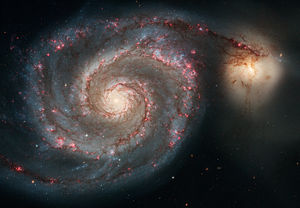- M51 Group
-
M51 Group 
The Whirlpool Galaxy (M51A), the brightest member of the M51 Group, and M51B, the companion to the Whirlpool Galaxy.Observation data (Epoch J2000) Constellation(s) Canes Venatici Right ascension 13h 24m[1][2] Declination 46° 13′[1][2] Number of galaxies 7-17[3][4][1][2] Brightest member Whirlpool Galaxy (M51A)[4][1][2] Other designations NGC 5194 Group, LGG 347,[1] NOGG H 712,[2]
NOGG P1 723,[2] NOGG P2 739[2]See also: Galaxy groups and clusters, List of galaxy clusters The M51 Group is a group of galaxies located in Canes Venatici. The group is named after the brightest galaxy in the group, the Whirlpool Galaxy (M51A). Other notable members include the companion galaxy to the Whirlpool Galaxy (M51B) and the Sunflower Galaxy (M63)[3][4][1][2].
Contents
Members
The table below lists galaxies that have been consistently identified as group members in the Nearby Galaxies Catalog,[3] the survey of Fouque et al.,[4] the Lyons Groups of Galaxies (LGG) Catalog,[1] and the three group lists created from the Nearby Optical Galaxy sample of Giuricin et al.[2]
Members of the M51 Group Name Type[5] R.A. (J2000)[5] Dec. (J2000)[5] Redshift (km/s)[5] Apparent Magnitude[5] M51B (NGC 5195) SB0 pec 13h 29m 59.6s +47° 15′ 58″ 465 ± 10 10.5 NGC 5023 Scd 13h 12m 12.6s +44° 02′ 28″ 407 ± 1 12.9 NGC 5229 SB(s)d 13h 34m 02.8s +47° 54′ 56″ 364 ± 8 14.3 Sunflower Galaxy (M63) SA(rs)bc 13h 15m 49.3s +42° 01′ 45″ 504 ± 4 9.3 UGC 8313 SB(s)c 13h 13m 53.9s +42° 12′ 31″ 593 ± 4 14.4 UGC 8331 IAm 13h 15m 30.3s +47° 29′ 56″ 260 ± 5 14.6 Whirlpool Galaxy (M51A) SA(s)bc pec 13h 29m 52.7s +47° 11′ 43″ 463 ± 3 9.0 Other probable members (galaxies listed in two or more of the lists from the above references) include IC 4263 and UGC 8320. The exact membership is somewhat uncertain.
Nearby Groups
The M51 Group is located to the southeast of the M101 Group and the NGC 5866 Group[6]. The distances to these three groups (as determined from the distances to the individual member galaxies) are similar, which suggests that the M51 Group, the M101 Group, and the NGC 5866 Group are actually part of a large, loose, elongated structure[6]. However, most group identification methods (including those used by the references cited above) identify these three groups as separate entities.
See also
External links
References
- ^ a b c d e f g A. Garcia (1993). "General study of group membership. II - Determination of nearby groups". Astronomy and Astrophysics Supplement 100: 47–90. Bibcode 1993A&AS..100...47G.
- ^ a b c d e f g h i G. Giuricin, C. Marinoni, L. Ceriani, A. Pisani (2000). "Nearby Optical Galaxies: Selection of the Sample and Identification of Groups". Astrophysical Journal 543 (1): 178–194. arXiv:astro-ph/0001140. Bibcode 2000ApJ...543..178G. doi:10.1086/317070.
- ^ a b c R. B. Tully (1988). Nearby Galaxies Catalog. Cambridge: Cambridge University Press. ISBN 0-521-35299-1.
- ^ a b c d P. Fouque, E. Gourgoulhon, P. Chamaraux, G. Paturel; Gourgoulhon; Chamaraux; Paturel (1992). "Groups of galaxies within 80 Mpc. II - The catalogue of groups and group members". Astronomy and Astrophysics Supplement 93: 211–233. Bibcode 1992A&AS...93..211F.
- ^ a b c d e "NASA/IPAC Extragalactic Database". Results for various galaxies. http://nedwww.ipac.caltech.edu/. Retrieved 2006-10-19.
- ^ a b L. Ferrarese, H. C. Ford, J. Huchra, R. C. Kennicutt Jr., J. R. Mould, S. Sakai, W. L. Freedman, P. B. Stetson, B. F. Madore, B. K. Gibson, J. A. Graham, S. M. Hughes, G. D. Illingworth, D. D. Kelson, L. Macri, K. Sebo, N. A. Silbermann (2000). "A Database of Cepheid Distance Moduli and Tip of the Red Giant Branch, Globular Cluster Luminosity Function, Planetary Nebula Luminosity Function, and Surface Brightness Fluctuation Data Useful for Distance Determinations". Astrophysical Journal Supplement 128 (2): 431–459. arXiv:astro-ph/9910501. Bibcode 2000ApJS..128..431F. doi:10.1086/313391.
Categories:- Galaxy clusters
- M51 Group
- Canes Venatici constellation
Wikimedia Foundation. 2010.
